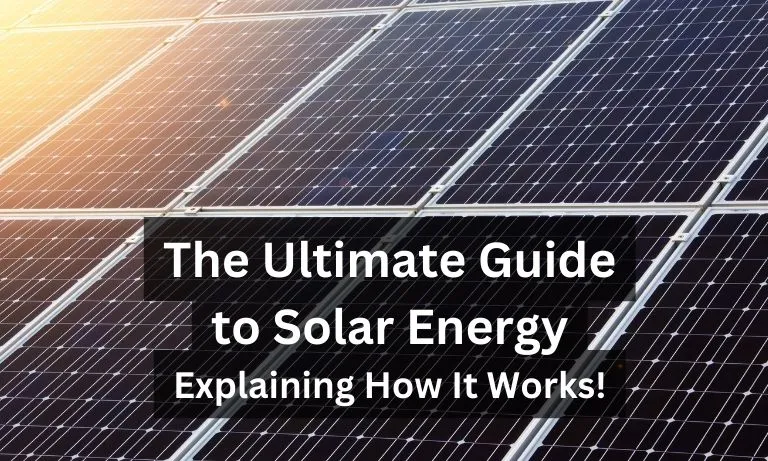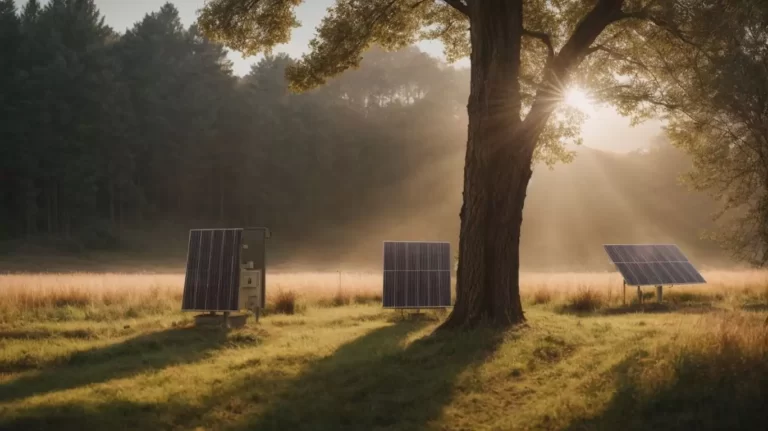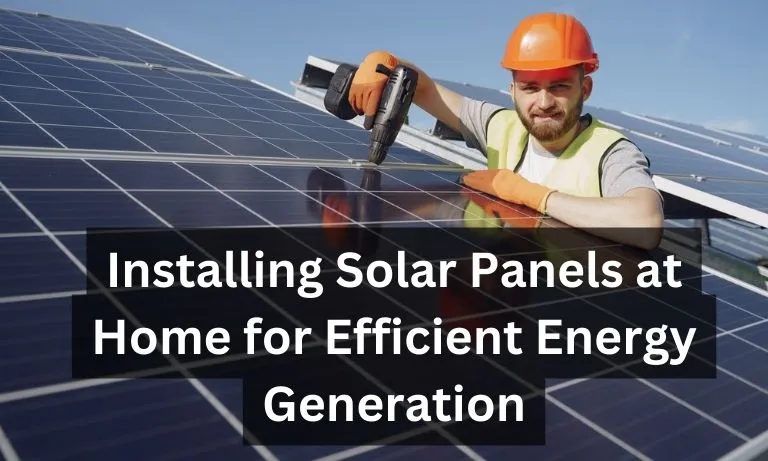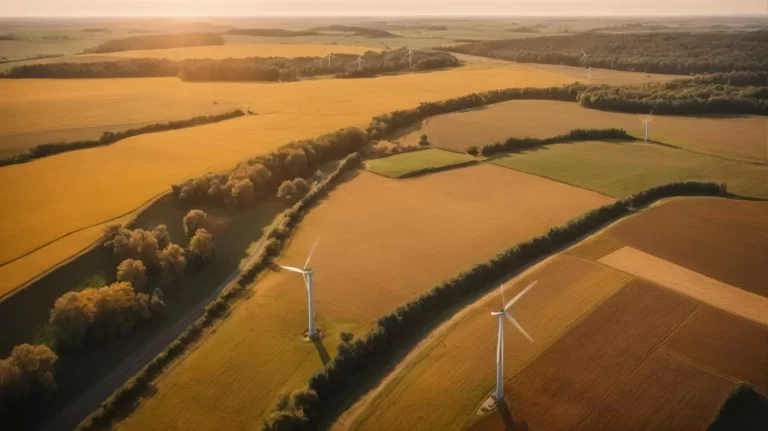Solar Power for Mobile Homes: Embrace Freedom and Sustainability while Traveling
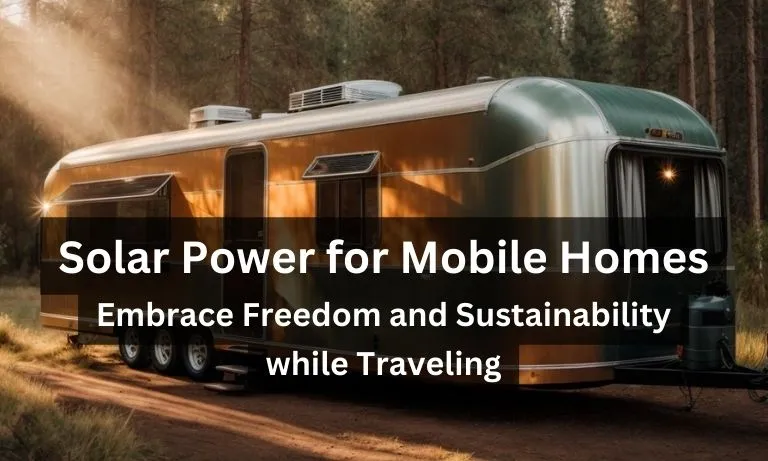
Are you tired of being tethered to the grid with your traditional home? Do you crave the freedom and sustainability that comes with a mobile lifestyle? Look no further! With the rise of solar power, mobile homes are now equipped to offer both. Join the movement towards a greener, more independent way of living.
What is Solar Power for Mobile Homes?
Solar power for mobile homes is the utilization of solar energy to power various electrical systems and appliances in mobile homes, such as RVs, campers, and tiny houses. This involves installing solar panels on the roof or an adjacent area of the mobile home, which capture sunlight and convert it into electricity. This renewable energy source offers numerous benefits for mobile homeowners, including independence from traditional power sources, reduced reliance on fossil fuels, and cost savings on energy bills.
Mobile homes equipped with solar power systems can generate electricity during the day, which can be stored in batteries for use at night or during periods of low sunlight. This provides a reliable source of electricity for mobile homeowners, even when they are off-grid or traveling to remote locations.
Incorporating solar power into mobile homes promotes sustainability and environmental consciousness, as it reduces greenhouse gas emissions and contributes to a cleaner energy future. It also allows mobile homeowners to enjoy the freedom and flexibility of living on wheels without sacrificing comfort and convenience.
In the early 2000s, a couple named Mark and Jenna made the decision to embrace a nomadic lifestyle and live in their RV full-time. However, they soon realized that relying on traditional power sources was limiting their freedom and causing unnecessary expenses. They took the leap and installed a solar power system on their mobile home, enabling them to generate their own electricity wherever they traveled. This not only gave them the ability to explore off-grid locations, but it also aligned with their dedication to sustainable living. Inspired by their experience, Mark and Jenna started a blog and YouTube channel to share their journey of living sustainably in a solar-powered mobile home, educating and inspiring others to do the same. Their story continues to motivate mobile homeowners worldwide to harness the power of the sun and live sustainably on wheels.
How Does Solar Power Work for Mobile Homes?
Solar power is a sustainable and efficient energy option for mobile homes. Here is a step-by-step guide on how solar power works for mobile homes:
- Assess energy needs: Determine the amount of electricity needed to power the mobile home and its appliances.
- Calculate solar panel requirements: Consider the available roof space and the amount of sunlight the location receives to determine the number and size of solar panels needed.
- Install solar panels: Mount the solar panels on the roof of the mobile home to capture sunlight and convert it into electricity.
- Connect to an inverter: The solar panels generate direct current (DC), which needs to be converted to alternating current (AC) for use. Install an inverter to convert the electricity.
- Connect to the electrical system: Connect the inverter to the mobile home’s electrical system to power its appliances and lights.
- Monitor and maintain: Regularly monitor the solar power system’s performance and clean the panels to ensure maximum efficiency.
With solar power, mobile homeowners can enjoy the freedom of off-grid living and contribute to a more sustainable future. Remember to consult with a professional installer for a customized solar power solution tailored to your mobile home’s unique needs.
What Are the Benefits of Solar Power for Mobile Homes?
As the popularity of mobile homes continues to rise, so does the interest in alternative power sources. One of the most promising options is solar power, which offers a multitude of benefits for those living on the go. In this section, we will explore the various advantages of utilizing solar power for mobile homes. From the freedom it provides to the cost savings and environmental sustainability, we will examine the different ways solar power can enhance the mobile home lifestyle.
1. Freedom from Traditional Power Sources
When it comes to utilizing solar power for mobile homes, one of the key benefits is the freedom it offers from traditional power sources. Here are some steps to achieve this freedom:
- Install solar panels on the roof of your mobile home to harness the power of the sun.
- Connect the solar panels to an inverter that converts the DC power generated by the panels into AC power usable by your home.
- Install a charge controller to regulate the flow of electricity from the solar panels to your batteries, ensuring they are charged efficiently.
- Connect your batteries to an inverter, which will convert the stored DC power into AC power for use in your mobile home.
- Ensure that your electrical system is properly wired to integrate the solar power system, allowing you to use the solar-generated electricity in your home.
A couple living in a remote area decided to go off-grid and rely solely on solar power for their mobile home. By embracing the freedom from traditional power sources, they were able to enjoy a sustainable and self-sufficient lifestyle. With their solar panels and battery storage system, they had a reliable source of electricity for all their daily needs, including powering their appliances and lighting up their home. They found immense satisfaction in knowing that they were reducing their carbon footprint and living in harmony with nature.
2. Cost Savings
Solar power for mobile homes offers significant cost savings for homeowners. By harnessing the sun’s energy, mobile homeowners can reduce or even eliminate their reliance on traditional power sources, resulting in substantial savings on monthly utility bills. Here are some steps to maximize cost savings with solar power:
- Invest in high-quality solar panels and equipment to ensure optimal performance and longevity.
- Position the panels strategically to capture the maximum amount of sunlight throughout the day.
- Use energy-efficient appliances and LED lights to minimize energy consumption.
- Install a battery storage system to store excess solar energy for use during cloudy or nighttime periods.
- Regularly monitor and maintain the solar power system to ensure its efficiency and effectiveness.
One example of cost savings through solar power for mobile homes is the story of Jane, who installed a solar power system on her RV. By utilizing solar energy, Jane was able to reduce her electricity bills by 80% and recoup her initial investment within five years. Now, she enjoys the benefits of sustainable and cost-effective energy while traveling.
3. Environmental Sustainability
Environmental sustainability is one of the key benefits of utilizing solar power for mobile homes. By harnessing energy from the sun, mobile homeowners can reduce their carbon footprint and contribute to a cleaner environment. Here are some steps to promote environmental sustainability with solar power:
- Install solar panels on the roof of your mobile home to generate clean and renewable energy.
- Monitor and optimize your energy consumption through smart energy management systems.
- Use energy-efficient appliances and devices to minimize energy waste.
- Reduce water consumption by investing in water-saving fixtures and utilizing rainwater harvesting systems.
- Implement proper insulation and weatherization techniques to ensure energy efficiency and minimize heat loss.
- Engage in eco-friendly habits such as recycling, composting, and reducing waste to further support sustainability.
These steps can help mobile homeowners make their homes more energy-efficient, reduce their reliance on traditional power sources, and contribute positively to the environment. By incorporating solar power and sustainable practices, mobile homes can become environmentally sustainable and promote a cleaner future.
What Are the Challenges of Using Solar Power for Mobile Homes?
While solar power is a popular and environmentally-friendly energy source, it presents unique challenges for those living in mobile homes. Understanding these challenges is crucial for successfully harnessing the power of the sun while on the move. In this section, we will discuss the main obstacles that come with using solar power for mobile homes, including limited space for solar panels, dependence on weather conditions, and the initial investment costs. We will also provide practical solutions such as using LED lights and installing a battery storage system to overcome these challenges.
1. Limited Space for Solar Panels
Limited space for solar panels is a common challenge when it comes to utilizing solar power for mobile homes. However, there are steps you can take to maximize the available space and still reap the benefits of solar energy. Here are some suggestions to make the most out of your limited space:
- Choose high-efficiency solar panels: Opt for solar panels with high conversion rates to generate more electricity in a smaller area.
- Utilize roof space: Mount the solar panels on the roof of your mobile home to take advantage of the available space without compromising living areas.
- Consider flexible solar panels: Flexible solar panels can be installed on curved or irregular surfaces, allowing you to utilize unconventional spaces for solar power generation.
- Use portable solar panels: Portable solar panels can be set up outside your mobile home to generate electricity while taking up minimal space inside.
- Explore vertical installations: If horizontal space is limited, consider vertical installations on the side walls of your mobile home to maximize solar panel capacity.
By implementing these steps, you can overcome the challenge of limited space for solar panels and enjoy the benefits of solar power in your mobile home.
2. Dependence on Weather Conditions
Dependence on weather conditions is a significant challenge when utilizing solar power for mobile homes. The availability of sunlight directly affects the efficiency of solar panels and the amount of energy generated. However, there are steps you can take to minimize the impact of weather conditions:
- Optimize panel placement: Install solar panels in areas that receive maximum sunlight, avoiding shading from trees or other structures.
- Invest in high-quality panels: Choose solar panels with high efficiency ratings to maximize energy production even in low-light conditions.
- Use a battery storage system: Install a battery storage system to store excess energy generated during sunny days. This allows you to use stored energy during periods of low sunlight.
- Monitor and adjust energy usage: Keep track of weather forecasts and adjust your energy usage accordingly. During cloudy days, reduce energy consumption by using energy-efficient appliances or minimizing electrical usage.
By following these steps, you can mitigate the impact of weather conditions on solar power for your mobile home and ensure a more reliable and sustainable energy source.
3. Initial Investment Costs
Investing in solar power for your mobile home may require an initial investment, but the long-term benefits far outweigh the upfront costs. Here are some steps to consider when managing the initial investment costs:
- Research and compare prices of solar panels from various manufacturers and suppliers.
- Explore leasing or financing options to spread out the initial investment over time.
- Calculate potential savings from reduced or eliminated electricity bills to determine the payback period.
- Look for available incentives or grants that can help offset the initial costs, such as federal tax credits or state rebates.
- Consult with solar installation professionals to receive accurate quotes and find the best deals.
Despite the initial costs, the long-term benefits of solar power for mobile homes are significant. Here’s a true story to illustrate this:
“After installing solar panels on their mobile home, the Johnson family saw a significant decrease in their electricity bills. Within five years, they had recouped their initial investment. Not only did they save money, but they also enjoyed the peace of mind that comes with using clean, renewable energy. The Johnsons now live comfortably and sustainably, knowing that their initial investment in solar power was well worth it.”
Invest in Energy-Efficient Appliances
Making the decision to invest in energy-efficient appliances is crucial when considering solar power for mobile homes. By selecting these appliances, you can fully utilize the benefits of your solar system and increase energy savings.
Follow these steps to help guide you in the process:
- Research and compare the various energy-efficient appliances available on the market, such as refrigerators, air conditioners, and water heaters.
- Look for appliances with an ENERGY STAR label, as they adhere to strict energy efficiency guidelines.
- Consider the size and capacity of the appliances to ensure they meet your specific needs.
- Calculate the estimated energy consumption and compare it with your solar power system’s capacity to ensure it can handle the load.
- Check the appliance’s energy efficiency rating, usually shown as an Energy Efficiency Ratio (EER) or Seasonal Energy Efficiency Ratio (SEER) for cooling appliances, and Energy Factor (EF) for water heaters.
- Consider investing in appliances with features like programmable timers, smart technology, and energy-saving modes.
- Consult with a solar power expert or an energy auditor to determine the best energy-efficient appliances for your mobile home.
Investing in energy-efficient appliances not only helps reduce your carbon footprint, but it also leads to long-term cost savings. By following these steps, you can enjoy the sustainability and freedom of solar power while maximizing energy efficiency in your mobile home.
2. Use LED Lights
Using LED lights in your mobile home is a simple and effective way to increase its energy efficiency, especially when utilizing solar power. LED lights are highly efficient and have a longer lifespan compared to traditional incandescent bulbs. Here are the steps to incorporate LED lights into your mobile home:
- Replace all existing incandescent bulbs with LED bulbs. LED bulbs use up to 75% less energy and can last up to 25 times longer.
- Consider using LED strip lights or undercabinet lighting for accent lighting. These lights consume less energy and can create a cozy ambiance in your mobile home.
- Install dimmer switches for your LED lights. This allows you to adjust the brightness according to your needs, saving even more energy.
In addition to using LED lights, you can further enhance your mobile home’s energy efficiency by investing in energy-efficient appliances and installing a battery storage system. These steps, combined with solar power, can significantly reduce your energy consumption and carbon footprint while providing you with sustainable and cost-effective power for your mobile home.
3. Install a Battery Storage System
Installing a battery storage system is a crucial step in making your mobile home more energy-efficient with solar power. This system allows you to store excess energy generated by your solar panels for later use, ensuring a continuous power supply even when the sun is not shining. Here are the steps to install a battery storage system:
- Assess your energy needs: Determine how much energy you consume on a daily basis to help you select the right battery capacity.
- Select the right battery: Consider factors such as capacity, voltage, and lifespan when choosing a battery that suits your needs.
- Install the battery management system: This system ensures the safe and efficient charging and discharging of the battery.
- Connect the battery to your solar panels: Consult a professional to properly connect the battery to your solar power system.
- Monitor and maintain the battery: Regularly check the battery’s performance and ensure proper maintenance to extend its lifespan.
By following these steps and incorporating a battery storage system, you can maximize the benefits of solar power for your mobile home, including increased energy independence and reduced reliance on traditional power sources.
What Are Some Examples of Mobile Homes Using Solar Power?
As the popularity of solar power continues to rise, more and more people are turning to this sustainable energy source for their homes. But what about those who live on the go, in mobile homes? The good news is that solar power can be utilized in a variety of mobile homes, providing both freedom and sustainability on wheels. In this section, we will explore some examples of mobile homes using solar power, including tiny homes, RVs and campers, and converted vans.
1. Tiny Homes
When it comes to incorporating solar power into tiny homes, there are a few steps to consider:
- Evaluate energy needs: Determine the energy needs of your tiny home, including appliances, lighting, and heating or cooling systems.
- Assess solar potential: Analyze the solar potential of your location, considering factors like sunlight hours, shading, and roof orientation.
- Choose the right solar system: Select a solar system that fits the energy requirements of your tiny home, taking into account available roof space and budget.
- Install solar panels: Mount solar panels on the roof of your tiny home to harness solar energy. Ensure proper alignment and secure installation.
- Connect to an inverter: Connect the solar panels to an inverter, which converts the DC power from the panels into AC power for use in your home.
- Add batteries or grid connection: Decide whether to incorporate battery storage to store excess energy or connect your tiny home to the grid for backup power.
- Monitor and maintain: Regularly monitor your solar system’s performance and maintain it by cleaning panels, checking connections, and addressing any issues promptly.
By following these steps, you can successfully integrate solar power into your tiny home, reducing reliance on traditional power sources and enjoying the benefits of renewable energy.
2. RVs and Campers
RVs and campers are excellent candidates for utilizing solar power. By harnessing the power of the sun, they can become self-sufficient and environmentally friendly. Here are some steps to make your RV or camper more energy efficient with solar power:
- Assess your energy needs: Determine how much power you require on a daily basis to determine the size of the solar panel system you need for your RV or camper.
- Invest in high-quality solar panels: Choose efficient and durable panels specifically designed for RVs and campers that can withstand the rigors of travel.
- Install a charge controller: This device regulates the flow of electricity from the solar panels to the battery, preventing overcharging and extending battery life for your RV or camper.
- Add a deep cycle battery: This type of battery is designed to handle the constant charging and discharging typical of solar power systems in RVs and campers.
- Use LED lights: Replace traditional incandescent bulbs with energy-efficient LED lights to reduce power consumption in your RV or camper.
Pro-tip: Consider installing a solar-powered ventilation system specifically designed for RVs and campers to keep your vehicle cool during hot summer months, reducing the need for air conditioning and further conserving energy.
3. Converted Vans
Converted vans are a popular choice for those seeking the freedom and sustainability of a mobile home powered by solar energy. To make your converted van more energy-efficient with solar power, follow these steps:
- Install solar panels on the roof of your van to harness solar energy.
- Connect the solar panels to an inverter, which converts the solar energy into usable electricity.
- Install a charge controller to regulate the charging of your van’s batteries, ensuring optimal performance.
- Wire the solar panels, inverter, and batteries together to create a complete solar power system.
- Upgrade to energy-efficient appliances, such as low-power refrigerators or LED lights, to maximize the energy savings.
Fact: Converted vans offer a sustainable and eco-friendly way to travel, providing the freedom to explore while minimizing your carbon footprint.


